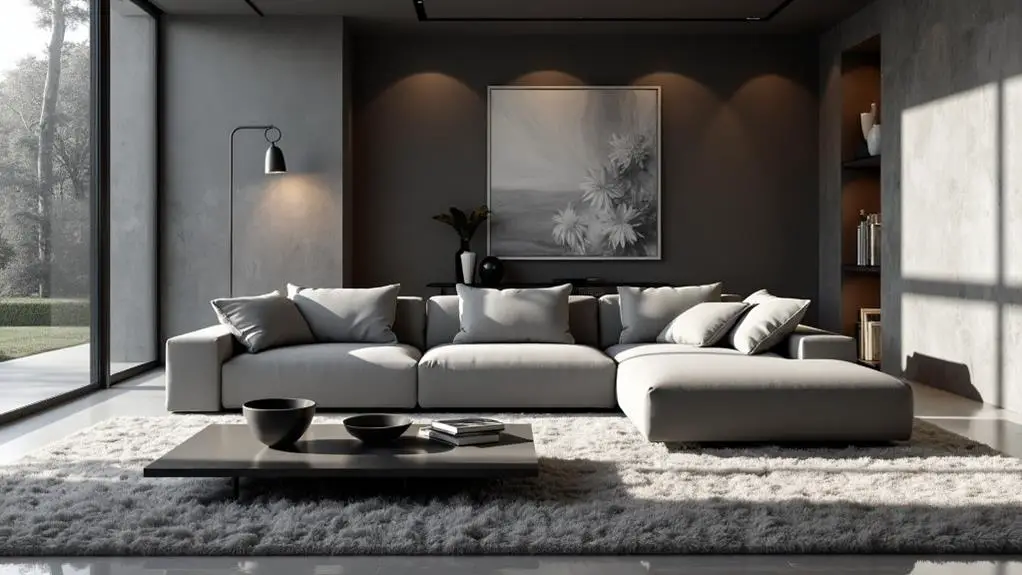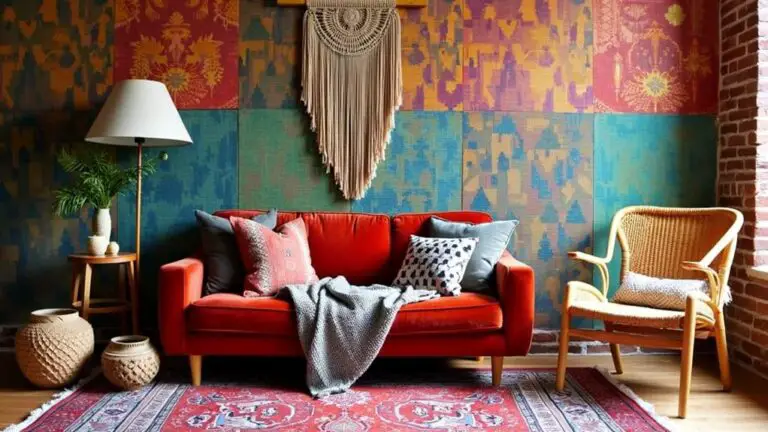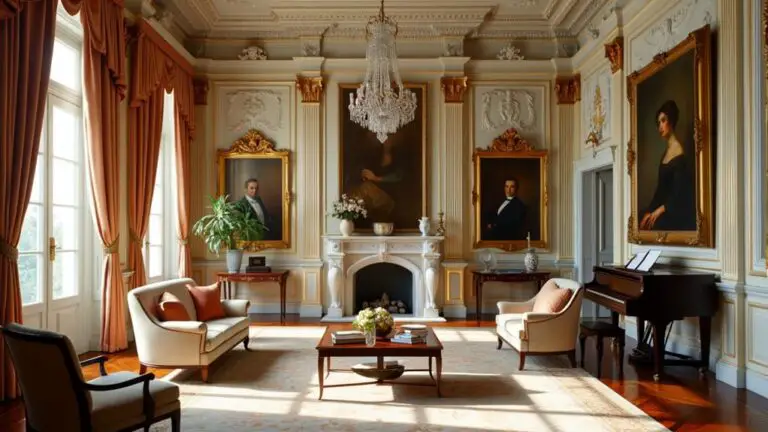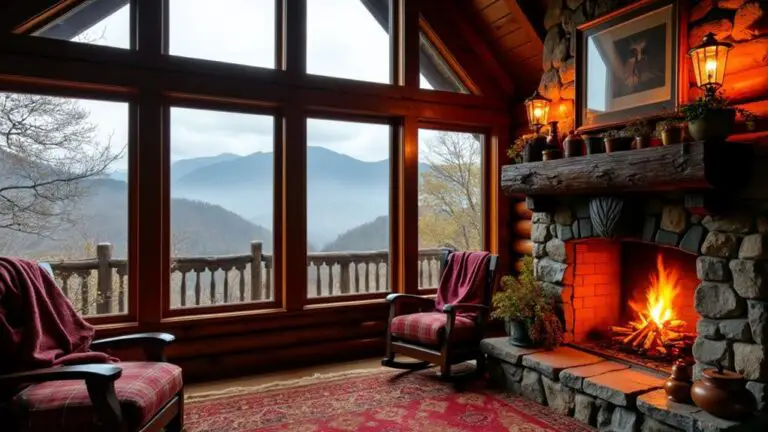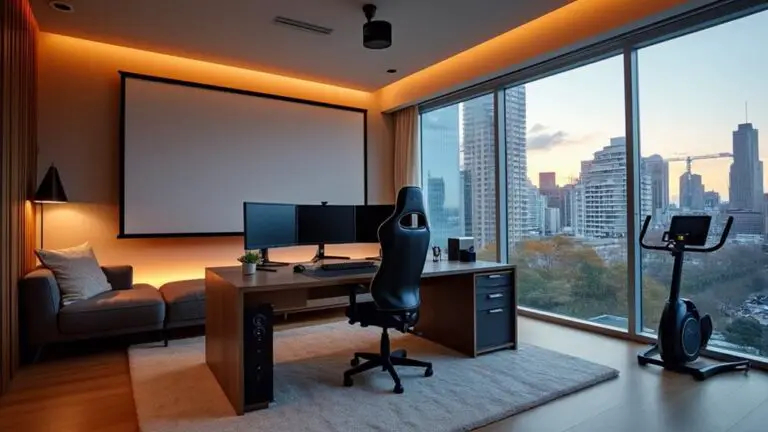Monochrome Marvels: Single-Color Room Makeover Magic
I've discovered the magic of monochrome room makeovers, and I'm amazed by their transformative power. By embracing a single color palette, I can create a cohesive and visually striking space that's both calming and dynamic. The key is to play with textures, patterns, and lighting to add depth and interest. From minimalist to traditional styles, monochrome designs work in any aesthetic. I've found that choosing easy-to-clean fabrics and maintaining the space regularly guarantees the longevity of this stunning look. Whether you're drawn to soothing blues or energizing reds, there's a monochrome marvel waiting to revolutionize your home.
What To Know
- Monochrome design uses a single color or shades for cohesive aesthetics, enhancing visual depth through material interplay.
- Texture variety is crucial, incorporating elements like velvet, linen, and wool for visual interest and warmth.
- Strategic lighting and reflective surfaces create dynamic interplay between light and shadow in single-color spaces.
- Accessorizing with varied patterns and unique pieces adds focal points while maintaining color scheme cohesion.
- Easy-to-clean, durable fabrics and regular maintenance ensure longevity and preserved beauty in monochrome rooms.
Embracing Monochrome Design
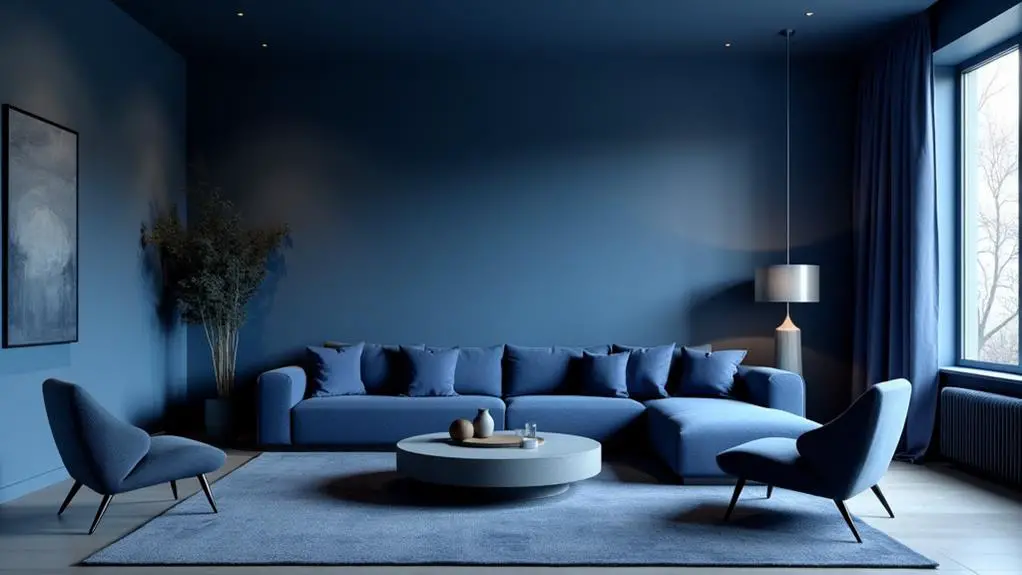
When it comes to embracing monochrome design, there's a world of possibilities waiting to be explored.
I've found that using a single color or various shades of it can create a cohesive and harmonious aesthetic in any space. The beauty of a monochromatic color scheme lies in its ability to enhance visual depth and texture, shifting focus from color alone to the interplay of materials and patterns.
I love how this approach makes spaces feel dynamic and inviting. Whether I'm working with neutrals, bold colors, pastels, or earth tones, each choice evokes a unique mood and atmosphere.
To keep things interesting, I mix textures and patterns within the same palette, preventing the room from appearing flat or monotonous. It's amazing how versatile monochrome fabrics and decor can be, allowing for effortless updates while maintaining a consistent look.
Color Psychology in Single-Hue Spaces
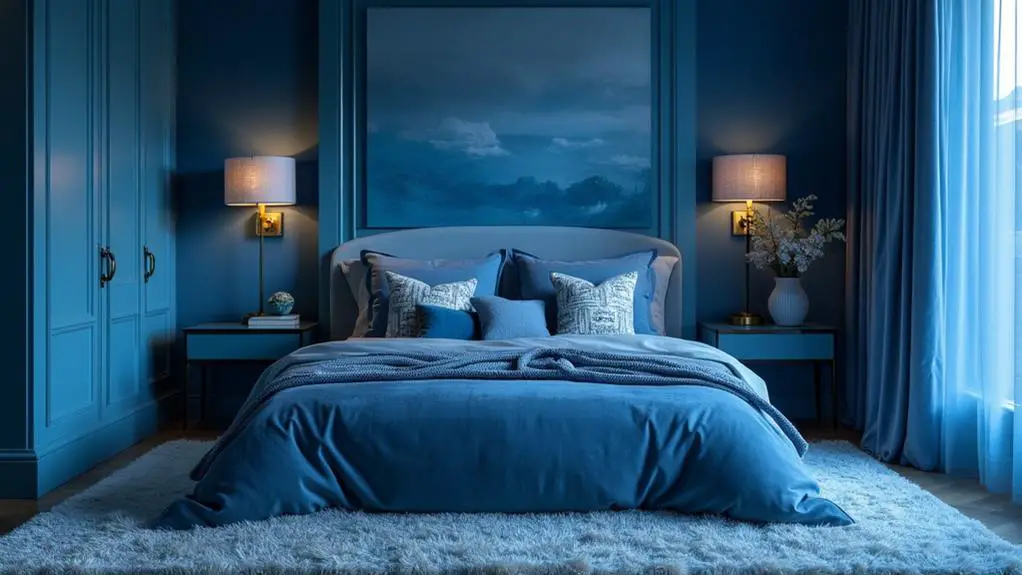
Color psychology plays an essential role in single-hue spaces, influencing our emotions and behaviors in subtle yet powerful ways. I've found that choosing the right color palette can transform a room's atmosphere and impact our mood considerably.
For instance, I've noticed that blue tones create a sense of calmness, while red stimulates energy and passion. When I use a single color in a room, it enhances focus and clarity by reducing visual distractions.
I've experimented with different shades and tints of a color to achieve various effects. Lighter shades create an airy feel, while darker ones add warmth and coziness.
For creative spaces, I prefer warmer monochrome palettes like yellows and oranges to promote creativity and positivity. I've also learned that monochromatic designs can alter space perception, with lighter colors expanding rooms and darker hues creating intimacy.
Texture: The Secret Ingredient
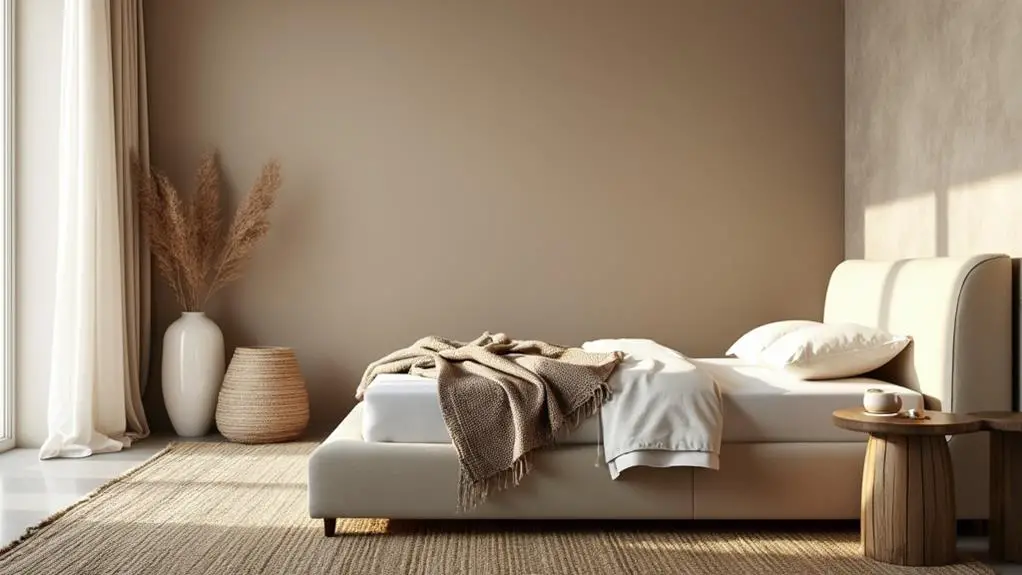
Texture breathes life into monochromatic spaces, transforming them from potentially dull to dynamically intriguing. I've found that incorporating various textures like velvet, linen, and wool is key to enhancing visual interest in a single-color room.
By layering different textures through rugs, cushions, and wall coverings, I create warmth and depth that makes the space feel more dynamic.
I love playing with varying shades of the same color to achieve a sophisticated, multi-dimensional look. Mixing patterns, such as stripes or geometric shapes, adds complexity and engages the eye.
The strategic use of textured fabrics not only enriches the room but also allows for easy layering and personalization. This flexibility in styling is essential when working with a monochrome palette.
Balancing Light and Shadow
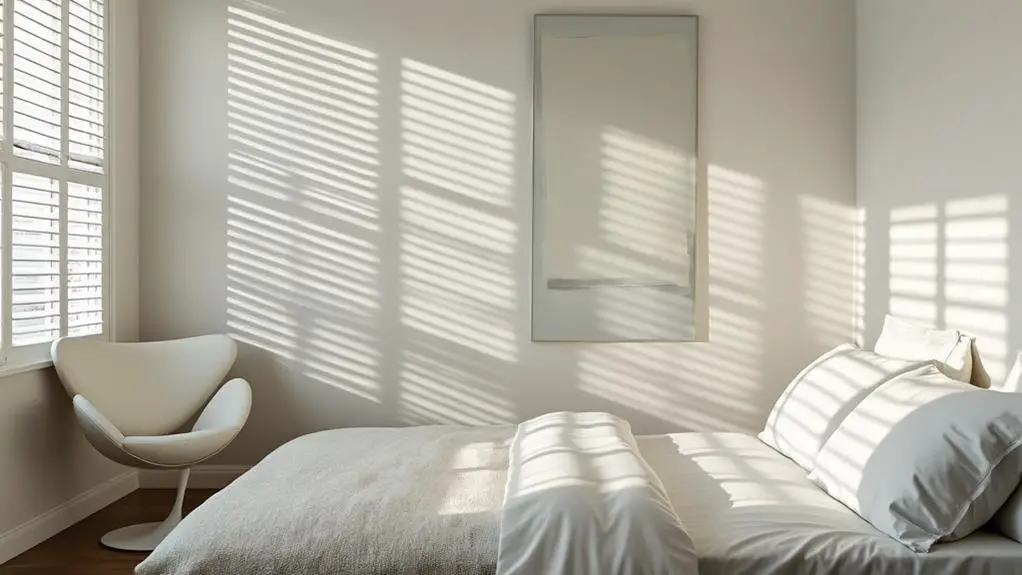
I'm excited to explore the art of balancing light and shadow in monochrome rooms.
We'll uncover dramatic contrast elements that breathe life into single-color spaces, and examine lighting techniques that create depth and interest.
I'll also show you how to master shadow play artistry, using darkness to enhance the overall ambiance and visual appeal of your room.
Dramatic Contrast Elements
When creating a single-color room, dramatic contrast elements can transform a potentially monotonous space into a visually engaging environment.
I've found that using different textures and strategically placing lighting can create a dynamic interplay between light and shadow, enhancing the overall depth of the space.
Lighting Techniques Explored
Lighting plays a pivotal role in bringing a single-color room to life. I've discovered that strategic placement of fixtures can enhance depth and texture in monochrome spaces.
By utilizing layered lighting techniques, I create a balanced interplay of light and shadow, adding visual interest to the room.
Here's how I explore lighting in monochromatic spaces:
- Use dimmers to adjust brightness and highlight different elements
- Incorporate reflective surfaces to amplify light distribution
- Play with color temperature to influence the room's ambiance
- Employ ambient, task, and accent lights for a well-rounded approach
I've found that the right lighting can transform a single-color room from flat to fabulous.
Shadow Play Artistry
Frequently overlooked, shadow play artistry is an essential element in elevating a monochrome room's design. I've found that manipulating light and dark contrasts creates a dynamic visual experience, enhancing depth and dimension in spaces. By incorporating different textures, like matte and glossy finishes, I can amplify the effects of light and shadow, making surfaces more engaging.
| Shadow Play Techniques | Effects |
|---|---|
| Strategic lighting | Defines areas |
| Textured surfaces | Enhances depth |
| Monochromatic palette | Focuses attention |
| Varied light intensity | Creates atmosphere |
I've discovered that strategic placement of light fixtures can create dramatic shadows, emphasizing architectural features and furniture pieces. Using a monochromatic color palette allows for a more focused exploration of shadow play, producing nuanced effects without the distraction of multiple hues. This interplay of light and shadow can evoke specific moods, from serene to dramatic, enhancing the overall aesthetic impact of the design.
Accessorizing for Visual Interest
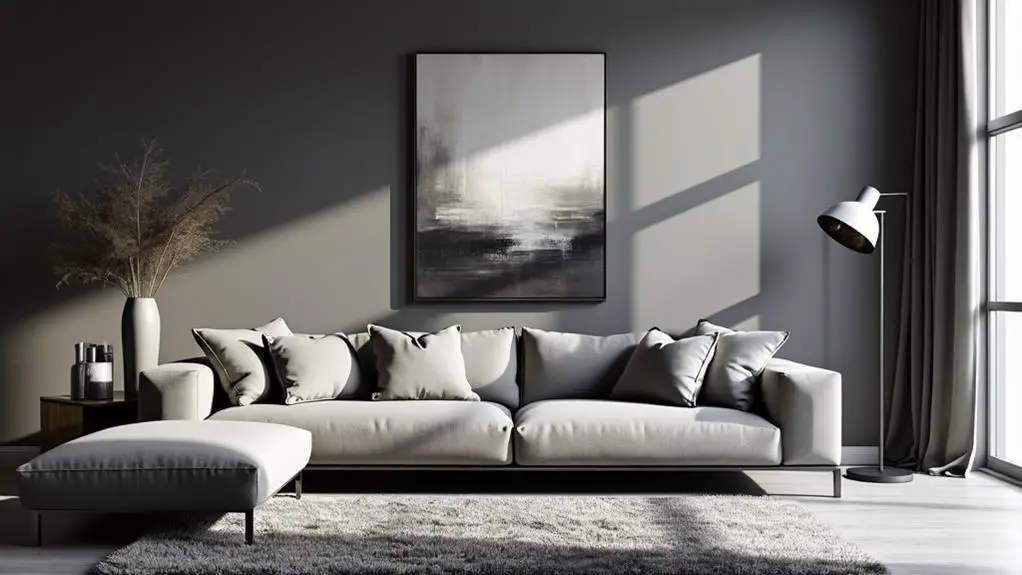
Transforming a single-color room from dull to dynamic often hinges on the art of accessorizing. I've found that using different textures, patterns, and accent pieces can breathe life into a monochromatic space.
When accessorizing for visual interest, I focus on:
- Mixing textures like velvet, linen, and wool
- Layering patterns while maintaining the color scheme
- Adding strategic accent pieces for focal points
- Incorporating unique accessories and light fixtures
I love playing with various shades and tones of the same color to create depth and complexity.
Well-chosen artwork, decorative objects, and contrasting shapes can elevate the room's aesthetic. By carefully selecting accessories that complement the overall design, I can craft a space that feels cohesive yet layered.
The key is to strike a balance between unity and diversity, ensuring each element contributes to the room's visual appeal without overwhelming it.
Monochrome in Different Design Styles
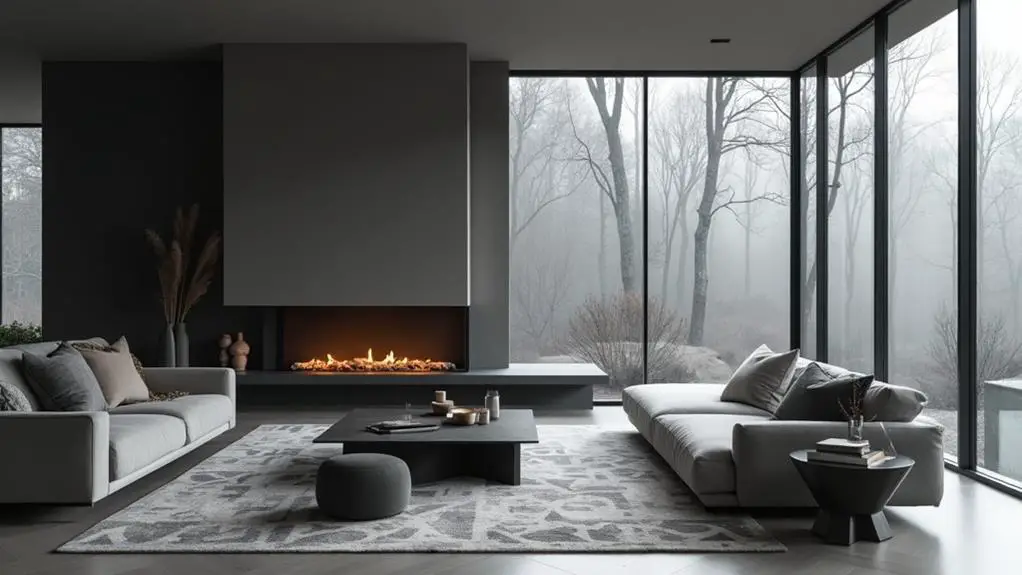
While accessorizing plays an essential role in single-color room design, the overall style of the space greatly influences how monochrome is applied.
I've noticed that monochrome design seamlessly integrates into various styles, each with its unique approach to color scheme. In minimalist interiors, I favor simplicity and clean lines using a single color palette.
For traditional spaces, I opt for rich, deep colors paired with ornate textures, creating an elegant look.
When working on contemporary designs, I use bold monochrome colors like navy or emerald green as striking focal points.
In Scandinavian-inspired rooms, I embrace light monochrome palettes with soft pastels and neutrals for a calm, airy feel.
For industrial styles, I incorporate dark tones like charcoal alongside raw materials, enhancing the urban vibe.
Each style offers exciting possibilities for monochrome magic.
Maintenance and Longevity

I've discovered that choosing easy-to-clean fabrics is essential for maintaining a monochrome room's beauty.
I recommend opting for stain-resistant upholstery and washable wall coverings, especially in high-traffic areas.
Easy-Clean Fabric Choices
How can you maintain your single-color room's pristine look without constant upkeep? The answer lies in choosing easy-clean fabrics for your interior design.
I've discovered that selecting the right materials can make a world of difference in preserving your monochrome marvel. Here are my top picks for easy-clean fabrics that'll keep your space looking fresh:
- Microfiber: Stain-resistant and machine-washable
- Treated polyester: Repels spills and cleans easily
- Vinyl: Sleek and wipe-clean for a polished look
- Leather: Durable and low-maintenance
I've found that these fabrics not only resist stains and spills but also stand up to wear and tear.
Many come with water-resistant finishes, making them perfect for high-traffic areas. By incorporating these easy-clean options, you'll extend the life of your upholstery and maintain that vibrant monochrome aesthetic for years to come.
Timeless Color Durability
Embracing a monochrome color scheme doesn't just create a striking visual impact; it also offers surprising benefits regarding durability and maintenance.
I've found that selecting the right monochrome color schemes can greatly reduce the visibility of wear and tear in my spaces. By using high-quality, durable paints and materials, I've enhanced the longevity of my monochrome designs. I've incorporated textured fabrics like velvet and linen, which not only look great but also withstand daily use while maintaining their appearance.
One of the best aspects of neutral monochrome schemes is how easy they're to update. I can seamlessly integrate new accessories without clashing with the established palette.
To keep my monochrome spaces looking fresh, I've made regular maintenance a priority. Dusting and gentle cleaning help preserve color vibrancy and texture, ensuring my design remains visually striking for years.
Conclusion
I've taken you through the ins and outs of monochrome magic, and now it's time to paint your own masterpiece. Remember, creating a single-color space isn't black and white – it's about finding the perfect balance of shade, texture, and light. Don't be afraid to think outside the box and make it your own. With these tips in your toolbox, you're ready to transform any room into a monochrome marvel that'll stand the test of time.

